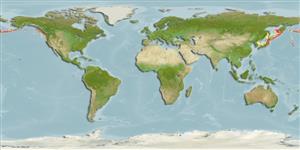Teleostei (teleosts) >
Perciformes/Scorpaenoidei (Scorpionfishes) >
Sebastidae (Rockfishes, rockcods and thornyheads) > Sebastolobinae
Etymology: Sebastolobus: Greek, sebastes = august, venerable + Greek, lobos = lobe (Ref. 45335).
More on author: Günther.
Environment: milieu / climate zone / depth range / distribution range
Ecology
Marine; bathydemersal; depth range 257 - 1537 m (Ref. 27311). Temperate; 55°N - 35°N
North Pacific: Sagami Bay, Japan to the southern Kuril Islands and off Sakhalin, Russia.
Length at first maturity / Size / Weight / Age
Maturity: Lm ?, range 28 - ? cm
Max length : 44.0 cm SL male/unsexed; (Ref. 56407); common length : 26.4 cm SL male/unsexed; (Ref. 56407); max. published weight: 1.2 kg (Ref. 56527)
Dorsal spines (total): 15 - 16; Dorsal soft rays (total): 8 - 10; Anal spines: 3; Anal soft rays: 5; Vertebrae: 27 - 30. Pectoral fin with notch, rays of lower lobe thick; head spine strongly and sharply produced; maxillary extending to middle of eye (Ref. 559). Body yellowish-red, a large black blotch on dorsal fin (Ref. 559).
Occurs in places with the steepest downthrow and sharp bends of sea bottom often in the places of the slope surrounded by large depths (the steep bottom relief causes vertical turbulent currents that provide the accumulation of food items) (Ref. 26289). Oviparous (Ref. 205). Eggs are extruded in floating gelatinous masses (Ref. 52092).
Eggs are enclosed in a gelatinous matrix which floats to the sea surface (Ref. 559). Females possess specialized ovarian structures including stalk-like ovigerous lamellae and secretory epithelia (Ref. 32832).
Robins, C.R., R.M. Bailey, C.E. Bond, J.R. Brooker, E.A. Lachner, R.N. Lea and W.B. Scott, 1991. Common and scientific names of fishes from the United States and Canada. Am. Fish. Soc. Spec. Publ. (20):183 p. (Ref. 3814)
IUCN Red List Status (Ref. 130435)
Threat to humans
Harmless
Human uses
Fisheries: commercial
Tools
Special reports
Download XML
Internet sources
Estimates based on models
Preferred temperature (Ref.
123201): 1.1 - 3.7, mean 2.5 °C (based on 89 cells).
Phylogenetic diversity index (Ref.
82804): PD
50 = 0.6250 [Uniqueness, from 0.5 = low to 2.0 = high].
Bayesian length-weight: a=0.00912 (0.00410 - 0.02027), b=3.09 (2.89 - 3.29), in cm total length, based on LWR estimates for this (Sub)family-body shape (Ref.
93245).
Trophic level (Ref.
69278): 3.2 ±0.40 se; based on food items.
Resilience (Ref.
120179): Low, minimum population doubling time 4.5 - 14 years (tm=10; Fec=69,355).
Fishing Vulnerability (Ref.
59153): High to very high vulnerability (69 of 100).
Nutrients (Ref.
124155): Calcium = 26.3 [11.3, 78.5] mg/100g; Iron = 0.377 [0.162, 0.807] mg/100g; Protein = 17 [15, 19] %; Omega3 = 1.05 [0.42, 2.83] g/100g; Selenium = 24.6 [10.1, 63.3] μg/100g; VitaminA = 27.3 [7.5, 101.4] μg/100g; Zinc = 0.607 [0.338, 0.980] mg/100g (wet weight);
